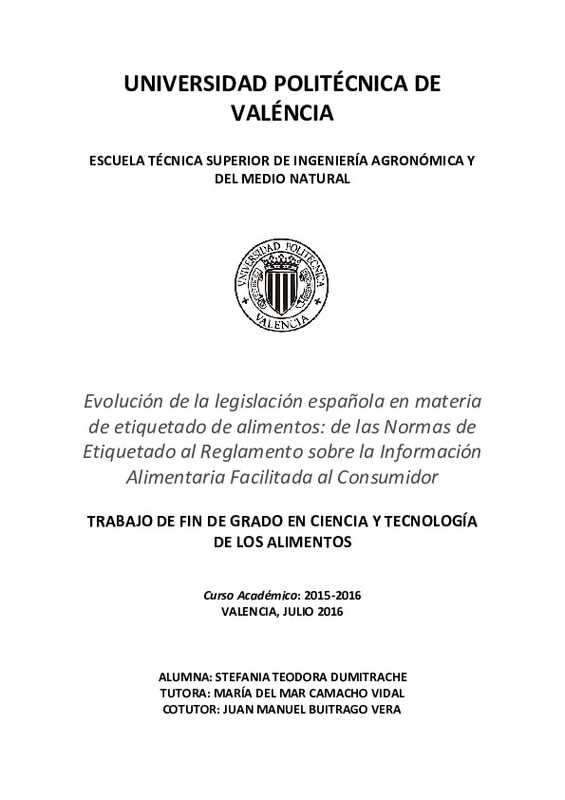JavaScript is disabled for your browser. Some features of this site may not work without it.
Buscar en RiuNet
Listar
Mi cuenta
Estadísticas
Ayuda RiuNet
Admin. UPV
Evolución de la legislación española en materia de etiquetado de alimentos: de las Normas de Etiquetado al Reglamento sobre la Información Alimentaria Facilitada al Consumidor
Mostrar el registro sencillo del ítem
Ficheros en el ítem
| dc.contributor.advisor | Buitrago Vera, Juan Manuel
|
es_ES |
| dc.contributor.advisor | Camacho Vidal, Mª Mar
|
es_ES |
| dc.contributor.author | Dumitrache, Teodora Stefania
|
es_ES |
| dc.date.accessioned | 2016-09-07T12:07:40Z | |
| dc.date.available | 2016-09-07T12:07:40Z | |
| dc.date.created | 2016-07-12 | |
| dc.date.issued | 2016-09-07 | es_ES |
| dc.identifier.uri | http://hdl.handle.net/10251/69001 | |
| dc.description.abstract | [ES] El etiquetado de los productos alimenticios es uno de los instrumentos más importantes para la consecución de uno de los objetivos primeros del Derecho Alimentario: la protección de los consumidores. Éste facilita la información necesaria sobre la naturaleza y las características de dichos productos, permitiendo así adquirirlos y consumirlos de manera segura. La legislación alimentaria, en general, y la del etiquetado en particular, ha cambiado y evolucionado mucho, sobre todo en los últimos tiempos. En poco más de treinta años se han desarrollado varias disposiciones legislativas que han supuesto variaciones importantes en el tipo de información y en la forma de presentarla. En este trabajo se ha estudiado la evolución de la legislación en materia de etiquetado, actualmente denominada información alimentaria facilitada al consumidor, a través de la revisión y la comparación entre la normativa publicada antes y después de la entrada de España en la Unión Europea. Por otra parte, y pensando que estos cambios legislativos no tienen sentido si no llegan al consumidor, se ha realizado un análisis, mediante una encuesta, del conocimiento y percepción por parte de los consumidores de la información a la que se puede acceder a través del etiquetado. Las conclusiones obtenidas con respecto a la evolución de la normativa a nivel nacional estriban en la gran evolución de la legislación en dicho sector en un corto periodo de tiempo. A pesar de que la legislación en materia de etiquetado se remonta a principios del siglo XX, ha sido en los últimos treinta años cuando se han producido los cambios más relevantes teniendo como principal objetivo la satisfacción e información de los consumidores. Considerando el objetivo principal de informar a los consumidores ha surgido la incógnita del conocimiento que estos tienen al respecto y para ello se ha realizado una encuesta. Los resultados de la encuesta permiten concluir que el interés del consumidor medio en la ciudad de Valencia es bastante elevado, no obstante son muchos los que determinan que es difícil leer las etiquetas. La difícil legibilidad no es la única batalla que ha de enfrentar el etiquetado. El desconocimiento de la actual normativa es también un obstáculo a superar. Quizás la falta de formación acerca del etiquetado de los productos y una limitada publicidad acerca de la normativa que regula el etiquetado de los alimentos hacen que pocos consumidores conozcan los cambios al respecto. A pesar de no saber que la presencia de la información nutricional, los alérgenos o la actual importancia por la legibilidad del etiquetado son el resultado de la implantación del Reglamento (UE) nº 1169/2011, son muchos los consumidores que tienen un criterio al respecto. Ante esta situación queda remarcada la necesidad de la formación en este ámbito tan importante en nuestra sociedad. | es_ES |
| dc.description.abstract | [EN] The labelling of the food products is one of the most important instruments for the attainment: the protection of the consumers, one of the principal aims of the Food Law. This one facilitates the necessary information about the nature and the characteristics of the above-mentioned products, allowing to acquire them this way and to consume them in a safe way. The food legislation, in general, and the labelling especially, has changed and improved a lot, especially in the last decades. In little more than thirty years several legislative dispositions have been developed, and have supposed important variations in the type of information and in the way of presenting the products. The aim of this work has been studying the evolution of the legislation for labelling, called nowadays “food information facilitated to the consumer”, across the review and the comparison between the regulation published before and after the entry of Spain in the European Union. On the other hand, these legislative changes do not make any sense if they do not get to the consumer. This way, an analysis has been realized, through a survey, measuring the knowledge and perception of the consumers about the information that they can obtain through the labelling. The conclusions obtained regarding the evolution of the national regulation rest on the evolution of the legislation on the above mentioned sector in a short period of time. In spite of the fact that the legislation for labelling goes back at the beginning of the 20th century, it has been during the last thirty years, when the most relevant changes have taken place, having as first objective the satisfaction and ¿information of? The consumers. Considering the aim of informing the consumers, there has arisen the mystery of the knowledge that these have on consumers and that is the reason of the survey. The results of the survey allow to conclude that the interest of the average consumer, in the city of Valencia, is high enough, nevertheless there are many who determine that it is difficult to read the labels. The difficult legibility is not the only battle that the labelling has to face, the ignorance of the current regulation is also an obstacle to overcome. Probably the lack of formation of the labelling of the products and a rare advertising of the normative that regulates the labelling of the food, make that only a small number of consumers to know about the changes in the matter. Despite not knowing the presence of the nutritional information, the allergens or the current importance on the legibility of the labelling, they are the result of the implantation of the Regulation (EU) n º 1169/2011 and there are many consumers who have a criterion in the matter. Due to this situation, it is highlighted the necessity of formation in this area, because of the importance in our society. | es_ES |
| dc.format.extent | 36 | es_ES |
| dc.language | Español | es_ES |
| dc.publisher | Universitat Politècnica de València | es_ES |
| dc.rights | Reserva de todos los derechos | es_ES |
| dc.subject | Etiquetado de alimentos | es_ES |
| dc.subject | Legislación | es_ES |
| dc.subject | Consumidor | es_ES |
| dc.subject | Reg (UE) 1169/2011 | es_ES |
| dc.subject | Food labelling | es_ES |
| dc.subject | Legislation | es_ES |
| dc.subject | Consumer | es_ES |
| dc.subject.classification | ECONOMIA, SOCIOLOGIA Y POLITICA AGRARIA | es_ES |
| dc.subject.classification | TECNOLOGIA DE ALIMENTOS | es_ES |
| dc.subject.other | Grado en Ciencia y Tecnología de los Alimentos-Grau en Ciència i Tecnologia dels Aliments | es_ES |
| dc.title | Evolución de la legislación española en materia de etiquetado de alimentos: de las Normas de Etiquetado al Reglamento sobre la Información Alimentaria Facilitada al Consumidor | es_ES |
| dc.type | Proyecto/Trabajo fin de carrera/grado | es_ES |
| dc.rights.accessRights | Abierto | es_ES |
| dc.contributor.affiliation | Universitat Politècnica de València. Departamento de Tecnología de Alimentos - Departament de Tecnologia d'Aliments | es_ES |
| dc.contributor.affiliation | Universitat Politècnica de València. Escuela Técnica Superior de Ingeniería Agronómica y del Medio Natural - Escola Tècnica Superior d'Enginyeria Agronòmica i del Medi Natural | es_ES |
| dc.description.bibliographicCitation | Dumitrache, TS. (2016). Evolución de la legislación española en materia de etiquetado de alimentos: de las Normas de Etiquetado al Reglamento sobre la Información Alimentaria Facilitada al Consumidor. http://hdl.handle.net/10251/69001. | es_ES |
| dc.description.accrualMethod | TFGM | es_ES |
| dc.relation.pasarela | TFGM\48106 | es_ES |
Este ítem aparece en la(s) siguiente(s) colección(ones)
-
ETSIAMN - Trabajos académicos [3541]
Escuela Técnica Superior de Ingeniería Agronómica y del Medio Natural







